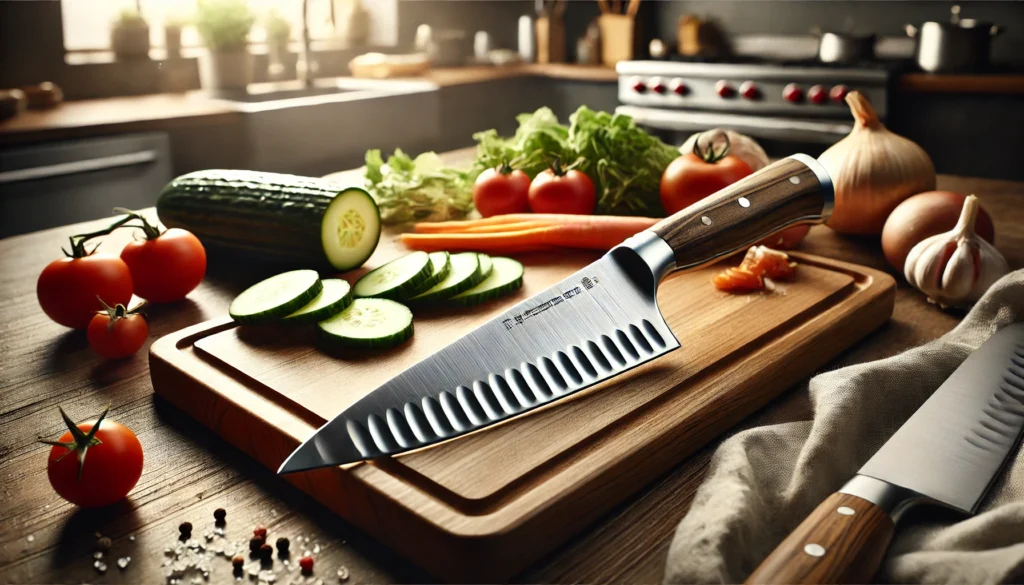
In culinary arts, the right tools can make all the difference. Knives hold a special place among these essential tools. Each type of knife has a specific purpose, and understanding their uses can elevate your cooking from average to exceptional. One such knife that often piques curiosity is the hollow-edge knife.
This comprehensive guide will explore the purpose of a hollow-edge knife, its benefits, and how to use and maintain it.
What is a Hollow Edge Knife Used For? (Short Answer)
A hollow-edge knife is used for slicing without food sticking to the blade. It’s great for cutting meats, vegetables, and cheeses smoothly. The dimples on the blade help with making precise cuts. It’s also helpful in preparing sushi by keeping slices clean and neat. This knife is versatile and helps in many kitchen tasks.
Introduction to Hollow Edge Knives
A hollow-edge knife, sometimes called a Granton-edge knife, is distinguished by its unique indentations—or “hollows”—along its blade. These dimples are spaced evenly along both sides, just above the cutting edge. But what is the purpose of these hollows, and how can they benefit your culinary endeavors? Let’s delve into the specifics.
Critical Characteristics of Hollow Edge Knives
- Indentations:
The hallmark of this knife is that these tiny, shallow grooves are designed to reduce friction.
- Blade Design:
Typically, the blade is straight-edged, making it versatile for various kitchen tasks.
- Materials:
Like other high-quality knives, hollow-edge knives are usually made from stainless or high-carbon steel for durability and sharpness.
The Purpose of a Hollow Edge Knife
The primary function of the hollows or dimples on the blade is to create air pockets between the knife and the food as you cut. This design innovation brings several key benefits:
- Reduced Sticking
One of the most frustrating aspects of chopping sticky foods, such as potatoes or cheese, is having them cling to the blade. The indentations on a hollow edge knife significantly reduce this problem. As you slice, air pockets form, preventing food from sticking and allowing for smoother, more efficient cuts.
- Precision Slicing
Precision is crucial whether you’re preparing paper-thin slices of vegetables or portioning delicate proteins like fish. The reduced friction from the hollows allows for cleaner, more precise cuts. This is particularly beneficial in professional kitchens where presentation matters as much as taste.
- Enhanced Versatility
Hollow-edge knives are versatile and can be used for various tasks, from slicing and dicing to mincing and chopping. Their design provides flexibility without compromising performance, making them valuable to any chef’s toolkit.
Common Uses of a Hollow Edge Knife
Knowing the theory is one thing, but how does this knife perform in real-world kitchen scenarios? Here are some typical applications:
- Slicing Meats
A hollow-edge knife excels at slicing meats, including roasts, hams, and poultry. The indentations help prevent thin slices from sticking to the blade, making it easier to achieve uniform cuts. This is especially useful for presentation purposes in both home and professional kitchens.
- Cutting Vegetables
The hollow-edge knife proves invaluable for vegetables, particularly those with a high water content, like cucumbers, zucchini, and eggplants. The reduced friction facilitates smoother slicing, enhancing overall efficiency and precision.
- Preparing Sushi
Sushi chefs often use hollow-edge knives to prepare delicate fish and vegetables. The knives’ non-stick properties are crucial for maintaining the integrity of the thin, precise cuts required for sushi, ensuring that each piece is expertly crafted.
- Cheese Cutting
Cheese, exceedingly soft varieties, tends to cling to blades, making a mess and slowing down prep time. A hollow-edge knife alleviates this issue, allowing for cleaner cuts and less waste.
Choosing the Right Hollow Edge Knife
If you’re considering adding a hollow-edge knife to your collection, keep these tips in mind:
- Blade Length
Hollow-edge knives come in various lengths. Choose a size based on your primary use. For instance, a longer blade is better for slicing significant cuts of meat, while a shorter blade may be more suitable for everyday vegetable prep.
- Handle Comfort
As with any knife, comfort is paramount. Look for a handle that feels secure and comfortable in your hand, providing reasonable control without causing strain during prolonged use.
- Quality of Steel
Opt for a knife made from high-quality stainless steel or high-carbon steel. These materials offer superior sharpness, durability, and resistance to corrosion.
Caring for Your Hollow Edge Knife
Maintaining your knife properly ensures it remains in top condition and extends its lifespan. Here are some care tips:
- Regular Sharpening
Even the best knives require regular sharpening to maintain their edge. Use a whetstone or a professional sharpening service to keep your hollow-edge knife sharp.
- Proper Cleaning
Avoid placing your knife in the dishwasher. Instead, hand wash it with mild soap and water, then dry it immediately to prevent any potential rusting or damage.
- Safe Storage
Store your knife in a dedicated knife block, magnetic strip, or protective sheath to keep the blade safe and reduce the risk of accidents.
Conclusion:
The hollow-edge knife is a versatile and innovative tool that significantly benefits amateur and professional chefs. Its unique design reduces friction, enhances precision, and minimizes food sticking, making it perfect for kitchen tasks. From slicing meats and vegetables to preparing delicate sushi and cheeses, this knife can elevate your culinary skills. Investing in a high-quality hollow-edge knife and adequately caring for it will ensure you reap the benefits for years. Whether you’re a seasoned chef or just starting your culinary journey, understanding the uses and advantages of a hollow-edge knife can make a remarkable difference in your kitchen adventures.
FAQs
A hollow-edge knife is used for various kitchen tasks, such as slicing meats, cutting vegetables, and preparing sushi. The indentations on the blade create air pockets that prevent food from sticking, making cutting smoother and more efficient.
A hollow-edge knife is excellent for cutting cheese, an exceedingly soft variety. The blade’s dimples reduce sticking, resulting in cleaner cuts and less mess during preparation.
Absolutely. A hollow-edge knife works well with fruits and vegetables, particularly those with high water content, like tomatoes and cucumbers. The reduced friction helps achieve precise and clean cuts.
Sushi chefs often use hollow-edge knives to cut delicate fish and vegetables. The air pockets the indentations create prevent sticking, making achieving the thin, precise cuts needed for sushi easier.
Yes, a hollow-edge knife is versatile and can be used for everyday cooking tasks such as chopping, slicing, and dicing. Its design makes it a valuable tool for home cooks and professional chefs.
A hollow-edge knife is used for slicing meats, cutting vegetables, and preparing sushi. The indentations on the blade keep food from sticking, making it easier to cut. This helps in achieving clean and precise slices.
A hollow point knife features a blade with small indentations along the edge. These indentations create air pockets to prevent food from sticking. It’s useful for slicing meats and vegetables cleanly.
Yes, you can sharpen a hollow edge knife. Use a whetstone or get it professionally sharpened. Regular sharpening keeps it effective for cutting.






